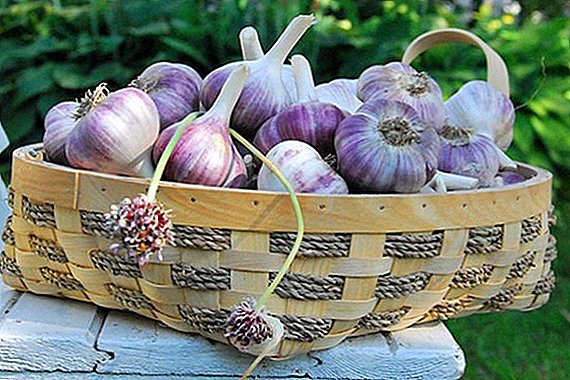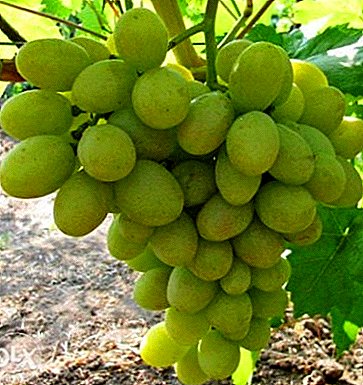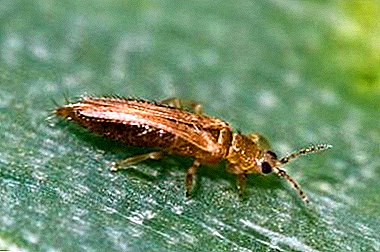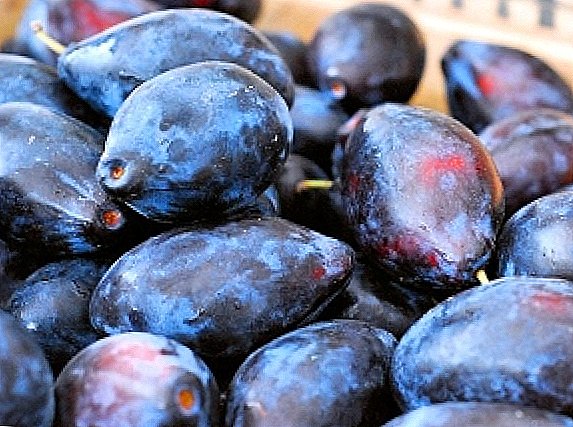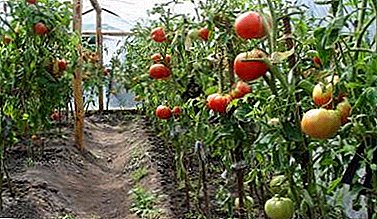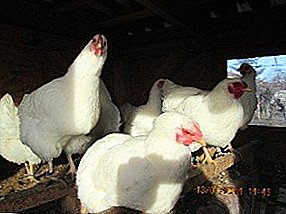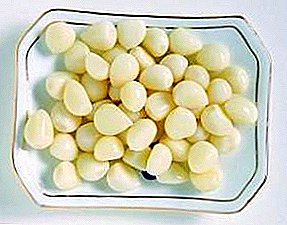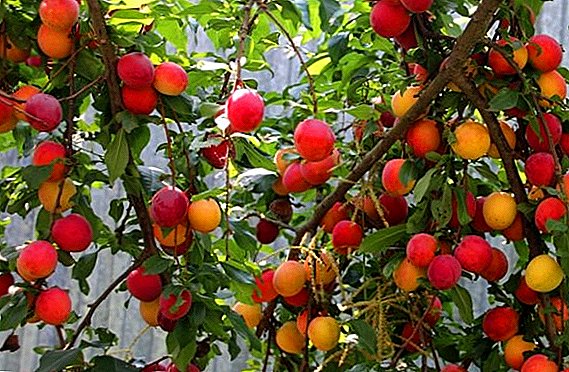 Many wild plants today are successfully grown in suburban areas. Some of them become an excellent decoration of the territory, while others are cultivated in order to produce tasty and healthy fruits. The latter should be attributed, and plum with all its many varieties. Juicy berries of this plant are ideal for cooking compotes, jams, jams and many other delicious dishes. In this article we will pay attention to the sort of cherry plum called Kuban comet, in the description of which there are many interesting facts.
Many wild plants today are successfully grown in suburban areas. Some of them become an excellent decoration of the territory, while others are cultivated in order to produce tasty and healthy fruits. The latter should be attributed, and plum with all its many varieties. Juicy berries of this plant are ideal for cooking compotes, jams, jams and many other delicious dishes. In this article we will pay attention to the sort of cherry plum called Kuban comet, in the description of which there are many interesting facts.
History of Cherry plum Kuban comet
Relatively recently (or more precisely, up to the 20s of the last century) plum was a wild-growing plant and was found mainly in the Crimea, in the Caucasus and in Central Asia. A little later, the breeders seriously started breeding its new varieties.
The first specimens did not differ much from the wild-growing variants in their taste, but even so, in a fairly short period of time the plant gained wide popularity. Such a universal love for cherry plum is explained by its unpretentious care and the highest yield: a year after planting you will receive the first berries, and after three you will get a stable harvest (up to 40 kg of fruit from one tree).  Thanks to the efforts of the same breeders, in 1987, a sort of cherry plum, called the Kuban comet, was introduced into the State Register of the Central, Nizhnevolzhsky, Northwestern and North Caucasian regions. In this case, the tasty and large berries were obtained by crossing the plum Chinese skoroplodnaya and cherry plum Pioneer.
Thanks to the efforts of the same breeders, in 1987, a sort of cherry plum, called the Kuban comet, was introduced into the State Register of the Central, Nizhnevolzhsky, Northwestern and North Caucasian regions. In this case, the tasty and large berries were obtained by crossing the plum Chinese skoroplodnaya and cherry plum Pioneer.
Did you know? Kuban comet - undersized hybrid, belonging to the group "Russian plum".
Description and features of the plum Kuban comet
Cherry plum Kuban comet is not very different from other varieties of its requirements for planting and care, but before choosing this plant, you must be familiar with its description. Firstly, it is a low-growing tree (it reaches a height of up to 3 meters), which, due to short overgrowing branches, cannot boast a lush crown. Secondly, this variety is partially self-bearing culture, and the laying of small flower buds can also occur on an annual increase.
Flowers Kuban comet - medium size and painted white. Sepals fit snugly to the petals, and the pedicle differs in medium length and thickness. Two flowers appear from one bud. The leaves of such a cherry plum are saturated green, with a glossy surface, rounded. At the edge of the leaf plate a slight waviness is noticeable. Gray shoots - horizontally arranged and characterized by medium thickness. 
Important! Despite the small length of the stem, it is firmly attached to the berries, so that even overripe fruits do not crumble.The main distinctive feature of the variety are large, egg-shaped berries, with a weakly pronounced suture and a slight wax coating. The skin of the red-burgundy fruit is quite thin, although it does not take strength. The flesh is yellow in color, with medium density and juiciness. This variety is valued for its high palatability: the fruits have a slight acidity, but on the whole are quite sweet (the flesh is separated from the stone only partially).
For the Kuban comet variety, high yields are common, but the regularity of obtaining a large number of fruits depends on the congestion of the tree. So, if there are too many berries on the branches, over time this will lead to their grinding. Abundant fruiting of this sort of cherry plum begins in the second year after planting (fruit ripening occurs at the end of July). Harvesting starts immediately, as soon as the skin of the berries becomes reddish. Collected fruits can be stored in the refrigerator for up to 25 days.
Alycha Kuban comet can please you with high winter hardiness and high natural adaptation capabilities, which makes it an excellent option for the middle zone. In addition, with the cultivation of this variety, you will not encounter a large number of pests and frequent plant diseases, although with prolonged rains, plum is still affected by fruit rot.  In order to avoid such a nuisance, it is necessary to timely trim the crown so that it remains lit and well ventilated. A competent approach to the cultivation of cherry plum will allow you to do without the use of chemicals in the care of her.
In order to avoid such a nuisance, it is necessary to timely trim the crown so that it remains lit and well ventilated. A competent approach to the cultivation of cherry plum will allow you to do without the use of chemicals in the care of her.
The advantages and disadvantages of the variety
Alycha Kuban comet has many advantages, which are probably known to all gardeners involved in its cultivation. So, The strengths of the variety include:
- high and stable yield;
- the possibility of obtaining large and attractive berries;
- high level of frost resistance;
- a long stay of overripe fruits on the branches (they do not fall off for a long time);
- good transportability;
- the integrity of the fruit and the low level of cracking during ripening.
Rules for selecting seedlings when buying
If you decide to plant a Kuban comet on your site, then the procedure must begin with the purchase of a good seedling that can quickly settle down on your site.
Important! When choosing a young tree of alycha Kuban comet, it is necessary to give preference to specimens with a closed root system.The main indicators of quality planting materials include:
- seedling height not less than 1-1.2 m;
- the presence of many small roots of the root system and its good ramification;
- swollen kidneys;
- the absence of any mechanical damage on the bark of the trunk and branches of the plant (also on them there should be no ulcers and traces of pests);
- wet, yellow-green cut of the shoot.
If you purchase seedlings in a special nursery, then be sure to pay attention to their trunks - they must be even and with healthy branches. 
Timing and site selection
The Kuban comet can be planted both in early spring and in autumn, but in the northern regions and in the middle zone it is better to plant young plants in spring.
When choosing a place for the future growth of a tree, pay attention to the southern and sunny parts of its territory. Planting seedlings of this variety in a shaded place will not help to obtain large and tasty fruits, and if there are drafts and winds, then you should not expect abundant harvests at all. The Kuban comet develops well when landing near buildings or high fences, where on one side it is covered by a solid wall.
 Does not like cherry plum and clay or loamy soils, and the most suitable option for it is to land on sandy and fertile soils with neutral acidity. It is also important to pay attention to the level of groundwater, it should not exceed 1 meter.
Does not like cherry plum and clay or loamy soils, and the most suitable option for it is to land on sandy and fertile soils with neutral acidity. It is also important to pay attention to the level of groundwater, it should not exceed 1 meter.
In a word, in order to succeed in cultivating the Kuban comet variety, prepare a place in advance in a well-lit and calm area with deep groundwater.
Preparatory work before landing
Choosing a place to plant, it remains to decide how to plant plum. First of all, it is necessary to prepare a planting hole, which is dug out 1-2 weeks before the direct planting of the plant (during spring planting). The pit size should be not less than 80x80x80 cm, and if you plan to plant several plants, then 3-3.5 m should be left between the neighbors (the power supply area of one tree is about 9 m²).
Fertilizers are necessarily made to the excavated recess. In the spring, the soil dug out of the pit can be mixed with half a bucket of humus (if possible, it is better horse), superphosphate (250 g) and potassium sulphide (40-50 g). If necessary, you can additionally add a solution of lime or ash to "deoxidize" the earth. But what cannot be used is nitrogen-containing fertilizers and fresh humus. The finished mixture is again poured into the pit at half its depth, making a kind of mound on which the seedling will be installed.
Important! If a pit for planting cherry plums is prepared in the fall, then as fertilizer it is better to use fresh manure or humus, which is left in the ground for the winter.
Step-by-step process of planting young cherry plum seedlings
 Before planting in open ground, seedlings of the Kuban comet are best placed in a clay mash for 1 hour or treated with a root formation stimulator. After that, a small amount of earth should be poured on the bottom of a previously prepared pit and a hill should be made of it. All further actions are performed in the following order:
Before planting in open ground, seedlings of the Kuban comet are best placed in a clay mash for 1 hour or treated with a root formation stimulator. After that, a small amount of earth should be poured on the bottom of a previously prepared pit and a hill should be made of it. All further actions are performed in the following order:
- A peg is driven into a hole and the seedling is lowered to such a depth that the root collar will rise 6 cm above the ground level.
- Then the young tree should be covered with earth and carefully tamped around the seedling.
- Then, with the help of a strong rope, plum is tied up to a peg hammered earlier.
- Around the sapling, at a distance of 40 cm, it is necessary to form a small hole, into which you will need to pour 2-3 buckets of water.
- Once the water is fully absorbed, it is possible to grind the hole with wood chips.
Important! Mulching is a very important component of cherry plum care, because thanks to the layer of mulch in the soil moisture is preserved and the plant will not suffer from drought.
Rules of seasonal care for cherry plum Kuban comet
For the abundant fruiting of a tree, one proper landing is not enough. The second important component of successful cultivation is care, which provides for compliance with certain requirements.
Pollen plum
The Kuban comet is partly a self-fertile variety, which means that other varieties of cherry plum need to be planted on the site to improve fruiting. The most suitable pollinators for cherry plum Kuban comet can be attributed to Maru, Pramen, Seyanets, Pchelnikovskuyu, Traveler and Present St. Petersburg. It will also be useful to plant Chinese plum varieties Orlovsky souvenir, Red Ball or Skoroplodnaya next to cherry plum.
Watering and mulching the soil
 An adult cherry plum tree is watered three times per season: in June, July and September, pouring 3-4 buckets of water at a time around the trunk at a time (some gardeners recommend watering 3-4 times a month). Young seedlings will have to be watered more often as the soil dries.
An adult cherry plum tree is watered three times per season: in June, July and September, pouring 3-4 buckets of water at a time around the trunk at a time (some gardeners recommend watering 3-4 times a month). Young seedlings will have to be watered more often as the soil dries.
The lack of moisture in the soil often causes a decrease in yield, which is especially important in the period from the beginning of June to the end of July. In August, watering is completely abolished, since excessive moisture leads to the rapid formation of young shoots, which with the onset of frost will quickly freeze.
Fertilization
If humus, superphosphate and potassium sulphide have already been introduced into the planting hole when a cherry plum is planted, then the following feeding should be done no earlier than one year before the flowering of the tree (in spring). Starting from the second year, the Kuban comet is fed 3-4 times per season:
- in the spring, a complex mixture with nitrogen (50 g / m²) is introduced into the soil;
- after flowering - potash-phosphorus mixture (40 g / m²);
- after fruiting, potassium sulphate; before wintering, the ground in the near wheel circle is mulched with compost or humus (0.5 buckets per 1 m²).
Did you know? Sometimes cherry plum is mistakenly called Mirabelle, but in fact Mirabelle is a different type of plum, in which the fruits are small, round and, unlike the cherry plum, are not characterized by high taste.
Cropping and crown formation
 Young shoots of cherry plum The Kuban comet grows rather quickly, and only by the fifth year of life does the growth length decrease slightly. It was at this time that the crown of the tree acquires a typical shape for the variety - it becomes flat-rounded, sometimes reaching 5 meters in diameter (at a plant height of 3 m).
Young shoots of cherry plum The Kuban comet grows rather quickly, and only by the fifth year of life does the growth length decrease slightly. It was at this time that the crown of the tree acquires a typical shape for the variety - it becomes flat-rounded, sometimes reaching 5 meters in diameter (at a plant height of 3 m).
In order to prevent excessive thickening, for three years gardeners perform cherry plum formation. When performing the procedure, only strong skeletal branches are left, and all other cuttings are shortened or cut at all, thereby thinning the crown. The most popular form of cherry plum is considered to be tierless and cup-shaped.
The main pruning of cherry plum is done in spring. With the advent of heat, all frozen and damaged branches are removed and crown formation is carried out. In the summer season, gardeners cut the branches only if necessary, if you need to remove dried branches and young shoots that grow inside the crown. Also in summer you can shorten too long branches.
With the arrival of autumn, the time comes for the sanitary pruning of the Kuban comet: removal of excess and descending branches. All dry and infected shoots are completely cut and burned.
Important! Pruning plum must be carried out every year, and in the spring, and in the summer (if necessary), and in the fall, treating the cutting sites with a garden pitch.
Protection against diseases and pests
The Kuban comet is distinguished by a rather high resistance to attacks of pests and diseases.however, some of them are inherent in her. Most often, the danger is represented by fruit trees growing nearby, because if you violate the requirements for the care and cultivation of agricultural crops, harmful insects and pathogens can also cross over to cherry plums.
 Diseases of plum are the same as plum, and the main ones are brown spot and rust on the leaves. Both diseases cause drying and leaf fall. To get rid of this trouble, cherry plum is sprayed with 1% Bordeaux liquid in the period before bud blooming and after flowering, although the 1% solution of copper sulfate, which needs to process the plant with the onset of spring, is perfect as an alternative control. As a preventive measure, be sure to collect all fall foliage in the fall, which is better to burn immediately.
Diseases of plum are the same as plum, and the main ones are brown spot and rust on the leaves. Both diseases cause drying and leaf fall. To get rid of this trouble, cherry plum is sprayed with 1% Bordeaux liquid in the period before bud blooming and after flowering, although the 1% solution of copper sulfate, which needs to process the plant with the onset of spring, is perfect as an alternative control. As a preventive measure, be sure to collect all fall foliage in the fall, which is better to burn immediately.
Often on the trunks of fruit trees one can notice glassy transparent growths, which are hardened gum, flowing from the wood. If you have noticed a similar phenomenon in your cherry plum, this may indicate an increase in soil acidity. In this case, it is necessary to limit fertilization as soon as possible and to equalize the soil pH, also by removing the formations and disinfecting the pruning sites.
When the fruit ripens, the Kuban comet may be subject to gray rot attacks. This fungal disease manifests itself in the form of chaotic gray growths on the surface of the bark and fruits, and also spreads very quickly.
 The affected fruit must be removed immediately, otherwise the entire crop will die in a few weeks. For the prevention of disease with the advent of spring, all trees are cherry plum sprayed with Bordeaux mixture, and after flowering they are treated with blue vitriol.
The affected fruit must be removed immediately, otherwise the entire crop will die in a few weeks. For the prevention of disease with the advent of spring, all trees are cherry plum sprayed with Bordeaux mixture, and after flowering they are treated with blue vitriol.
As for pests, in most cases alycha is attacked by aphid and downy silkworm. Both insects feed on the leaves, leaving small holes on them, which eventually cause the leaf plates to shrink and fall. For prophylactic purposes, trees are treated with special insecticides "Nitrafen" and "Verin" up to the very leafing.
In the cortex of the Kuban comet, bark beetles and fruit saplings often settle. They lay larvae, of which larvae later emerge, feeding on the sap of the tree and leaving behind themselves moves in its trunk. If time does not take measures to eliminate pests, the tree can shrink. In this case, the only way to get rid of pests is the use of insecticides "Dichlorvos", "Confidor", "Chlorophos". Processing trunks of cherry plum is carried out every two weeks, and the bark must be well moistened with a means. In the fall, all diseased branches are cut and burned.
Preparing for the winter
Alycha Kuban comet tolerates the winter frosts quite firmly, but in the first years after planting, young seedlings are better covered completely. For this purpose, you can use special garden materials (burlap or spunbond). It is not recommended to mulch the hole with straw or hay, since rodents can live there.
Harvesting and storage of cherry plum
The ripening of cherry plum of the described variety occurs in the middle of July, but the crop is removed in several visits. Основным признаком созревания является окрашивание плодов в насыщенно-красный цвет, а в полной спелости они становятся почти бордовыми.  Depending on the number of berries on the branches, the fruiting period can last for about two weeks, because first large and well-lit fruits ripen, and then all the others. Kuban comet is always abundantly fruiting, so do not delay with the collection of ripe berries, despite the fact that they are not prone to cracking or shattering. If you do not remove them from the tree in time, they will create an additional load on the branches and prevent the ripening of the remaining berries.
Depending on the number of berries on the branches, the fruiting period can last for about two weeks, because first large and well-lit fruits ripen, and then all the others. Kuban comet is always abundantly fruiting, so do not delay with the collection of ripe berries, despite the fact that they are not prone to cracking or shattering. If you do not remove them from the tree in time, they will create an additional load on the branches and prevent the ripening of the remaining berries.
The collected, fully ripe fruits of the Kuban comet should be stored at a temperature of + 3 ... +5 ° C for no longer than 10 days. Extend the shelf life of cherry plum, which is often required for the realization of the fruit, you can, having gathered a not completely ripe crop. Cherry plum refers to those plants whose fruits ripen well after removal. The commodity characteristic of the Kuban comet variety is very high: cherry plum tolerates transportation, does not rot and does not crumple, keeping its taste qualities for a long time (provided that the fruits were removed from the tree before full maturation).
Having planted the described variety on your plot, you will always have on hand tasty cherry plums, which are equally well suited for fresh consumption and for preparing delicious dishes using them.


